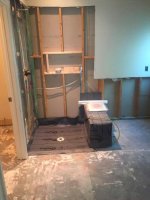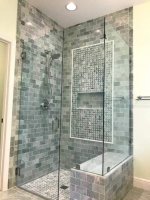Jadnashua
Retired Defense Industry Engineer xxx
FWIW, in the tile industry, neither the tile nor grout (or caulking) is considered the waterproofing in a shower...on the shower pan, it's the liner. A shower should not leak even before the tile is installed. Except for the pan, a conventional shower constructions only has the pan (and up, over the curb) with waterproofing, the walls typically are not waterproofed, but not damaged by being wetted. There's a moisture barrier behind or on top of the wall that prevents direct moisture form attacking the studs, but gravity causes the vast majority to just flow down the surface, and any that might penetrate, if it is done properly, can dry out in between since there's no gravity to push it deeper. Some materials wick moisture, but when built right, it does not cause damage.
Once water gets to things like the wooden structure, that's an indication that there's a system failure. Often, while you can patch it, the repair doesn't last.
The Tile Council of NOrth America is the industry bible on how to tile things including showers. There are numerous methods described in that manual (you can buy a copy from them, if you wish, or the procedure for a single build type). When you select one, and perform it properly, the shower should last until you decide to remodel, not because it failed. They are not hard, but are VERY detail oriented. 70-80% of tiled showers in the USA are not done according to industry standards...all it takes is one little mistake, and eventually, it is highly likely to fail. How quickly depends on how often it is used and what error(s) occurred in the build...it could vary from months to many years.
Benches, liners, and curbs are the three biggest areas of failure to follow instructions, with curbs being the most common, since most all showers have one, while benches, when installed, are probably next. The industry and plumbing code says NO penetrations lower than 2" above the top of the curb...none IN the curb at all. It's not uncommon for an installer to use CBU on a curb, and attach it with screws...can't reliably be done. Second is to not use the curb corners to seal where the liner must be cut to then form over the curb. The only place you can penetrate the curb is low on the outside to help hold the liner in place - nothing on the top or inside.
Once water gets to things like the wooden structure, that's an indication that there's a system failure. Often, while you can patch it, the repair doesn't last.
The Tile Council of NOrth America is the industry bible on how to tile things including showers. There are numerous methods described in that manual (you can buy a copy from them, if you wish, or the procedure for a single build type). When you select one, and perform it properly, the shower should last until you decide to remodel, not because it failed. They are not hard, but are VERY detail oriented. 70-80% of tiled showers in the USA are not done according to industry standards...all it takes is one little mistake, and eventually, it is highly likely to fail. How quickly depends on how often it is used and what error(s) occurred in the build...it could vary from months to many years.
Benches, liners, and curbs are the three biggest areas of failure to follow instructions, with curbs being the most common, since most all showers have one, while benches, when installed, are probably next. The industry and plumbing code says NO penetrations lower than 2" above the top of the curb...none IN the curb at all. It's not uncommon for an installer to use CBU on a curb, and attach it with screws...can't reliably be done. Second is to not use the curb corners to seal where the liner must be cut to then form over the curb. The only place you can penetrate the curb is low on the outside to help hold the liner in place - nothing on the top or inside.
Last edited:


